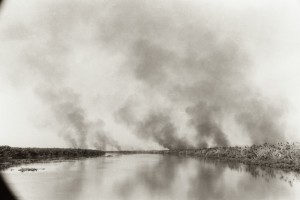
This piece first appeared at National Geographic.
An obscure indie-rock b-side kept running through my head last January as I hopped from city to city reporting on South Sudan’s freedom referendum.
The song was Two States, by the band Pavement. The words were simple, the music jaunty and driven.
Two states. We want two states.
North and south. Two states.
Forty million barrels!
Forty million barrels!
The lyrics seemed shockingly, if accidentally, appropriate to the break-up of Africa’s biggest country, and the high-stakes competition for the valuable oil located on Sudan’s contested north-south border. I grinned as the song persisted during my travels in Khartoum, Malakal, and Juba. After decades of civil war and life as second-class citizens, more than 98 percent of southern voters chose to leave Sudan and become masters of their own destinies.
But the chorus I recalled was wrong, misheard many years ago and never corrected.
The accurate chorus, tragically, is perhaps more fitting to the independent Republic of South Sudan than those I had imagined. It goes:
Forty million daggers!
Forty million daggers!
South Sudan is at war with itself. Or its tribes are at war with one another. In Jonglei state as many as a thousand members of the Murle tribe were massacred this month by members of the Lou Nuer. As Jeffrey Gettleman of the New York Times notes in this vivid and sad piece from the overrun city of Pibor, the bloodshed was revenge by the Nuer for raids by the Murle last August – less than a month after South Sudan became independent – in which 600 Nuer were killed, scores of children stolen, and untold heads of cattle seized.
South Sudan’s tribes have been raiding cattle (and people) from one another for hundreds of years. Cows are money, and prestige, and also something deeper. The young boys who guard the south’s massive cattle camps are deeply familiar with their bovine wards. One boy will be able to recognize each individual cow in a herd of hundreds – and will recall each one by name.
These raids took on a more deadly character in the late 1980s with the introduction of automatic weapons from Sudan’s north-south civil war. Raids that once involved spears and shields were now prosecuted with Kalashnikovs and sometimes even rocket-propelled grenades.

This mutation, or adaptation, was exemplified by the White Army, a giant force of Nuer (and some Dinka) fighters that first emerged to defend community property from outsiders and later became akin to a self-sustaining and independent fighting machine.
As the veteran Sudan researcher John Young notes in a 2007 study of the White Army, “…in contrast to similar [armed] groups in other areas its members became active participants in the civil war. Moreover, while most local armed groups remained under community control, the white army increasingly became an independent force that was at times highly destructive of the community from which it emerged.”
After Sudan’s civil war ended in 2005, southern leaders shut down the White Army in fighting that left at least 600 dead. Members of the Muele tribe located in southern Jonglei state were quick to exploit the power vacuum. They began raids that have continued on and off since 2006.
The Murle have a reputation has fierce, hard-core fighters. “They will eat dirt,” and go without water for days in the search for cattle to steal, a United Nations official once told me. The Nuer, of course, are also quite martial, and far more numerous. In fact, it was reportedly a reconstituted White Army that invaded Pibor this month. Muerle revenge attacks (for the Nuer revenge attacks) are already underway.
So where does the bloodshed end?
When, and how, do a proud and independent people agree to change?
Is there a model anywhere, any example, of armed pastoralists giving up the more destructive aspects of their culture and at the same time maintaining – or being permitted to maintain – their way of life?
